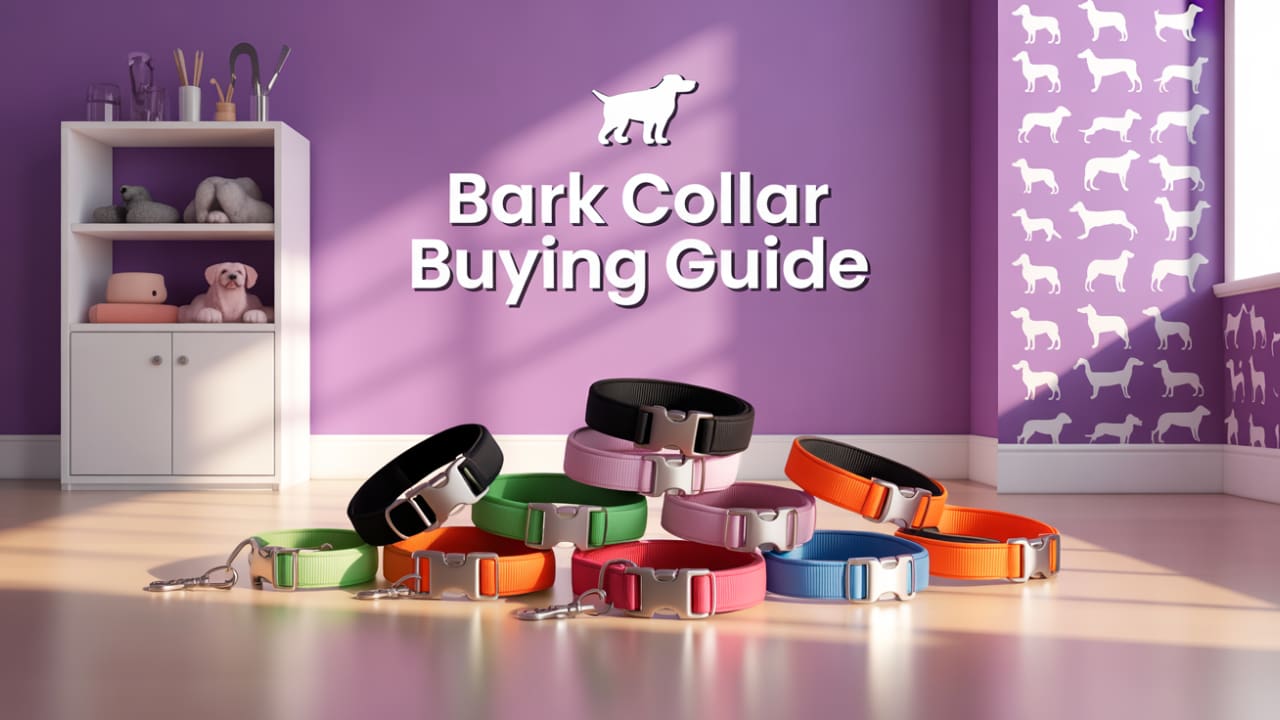Best Bark Collars for Dogs (2025 Guide): Expert Picks by Breed, Training Style, and Mistakes to Avoid
You love your dog, you really do. But the nonstop barking is driving everyone (you, your partner, your neighbors) up the wall.
You’ve probably searched for solutions, only to be overwhelmed by dozens of bark collar options, each claiming to be the safest and most effective.
So which ones actually work? The truth is, the best bark collars for dogs vary dramatically by breed, size, and personality. And choosing the wrong one could not only waste your money, but also stress out your pup.
Here’s the good news though. Humane bark collars that use vibration or ultrasonic cues are generally recommended for small or sensitive dogs, while remote-control models give owners more flexibility for training stubborn breeds like German Shepherds.
Still, there’s a catch. Many budget models cut corners on key features like smart bark detection or automatic shut-off, leading to false triggers and frustrated owners.
Let’s keep reading. You’re about to learn how to avoid those pitfalls, choose based on real behavior patterns, and discover which features actually make a difference in everyday life.
Understand the Different Types of Bark Collars and How They Work
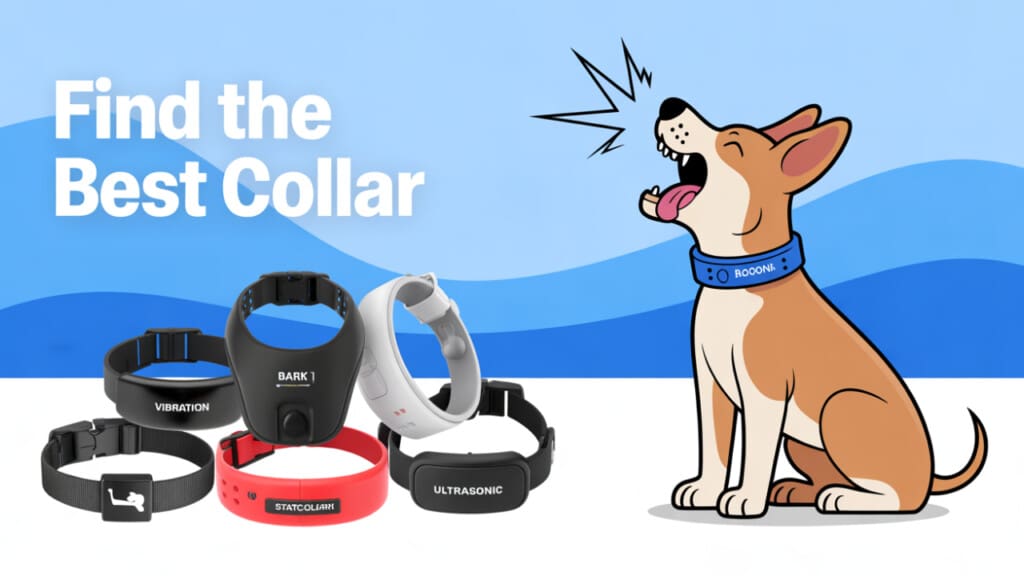
When it comes to choosing the best bark collars for dogs, understanding how each type functions is crucial.
Not all bark collars are created equal. And selecting the wrong one can not only waste money but also cause confusion or discomfort for your dog. So, what are your options?
To make things simple, there are five main types of bark collars on the market today: vibration collars, ultrasonic collars, static (shock) collars, spray collars, and smart collars.
Each works by detecting your dog’s bark (either through sound, vibration in the throat, or both) and delivering a response designed to interrupt the behavior.
Vibration bark collars gently vibrate when your dog barks, creating a sensation that distracts them. These are especially popular for small or sensitive breeds and are considered one of the more humane options.
Ultrasonic bark collars emit a high-pitched sound that’s inaudible to humans but annoying to dogs. These are a go-to for owners who want a no-contact, no-shock solution. However, they can be less effective in noisy environments or for hard-of-hearing dogs.
Static bark collars, often called shock collars, deliver a mild electric stimulation. While controversial, many modern models include adjustable intensity and safety shut-offs. Some trainers say that static collars can be effective for stubborn or large dogs when used responsibly, but they’re not for everyone.
Spray collars release a burst of citronella or unscented mist to distract your dog. They’re ideal for dogs that are sensitive to smells, though they do require refills and can become costly over time.
Smart bark collars take things to the next level with AI-powered bark recognition, customizable settings, and even smartphone syncing. They’re pricier. But they do offer precision and control that traditional collars can’t match.
Take note. Choosing the wrong collar for your dog’s size, temperament, or environment is one of the most common (and costly) mistakes pet owners make. That’s why it’s essential to understand how each collar works before buying.
We’re sure you’re still deciding which type suits your dog best. Let’s continue reading. The next section dives into how to match the collar to your dog’s breed and behavior.
2025 Tech Deep Dive: Smarter Than Just Vibration or Shock
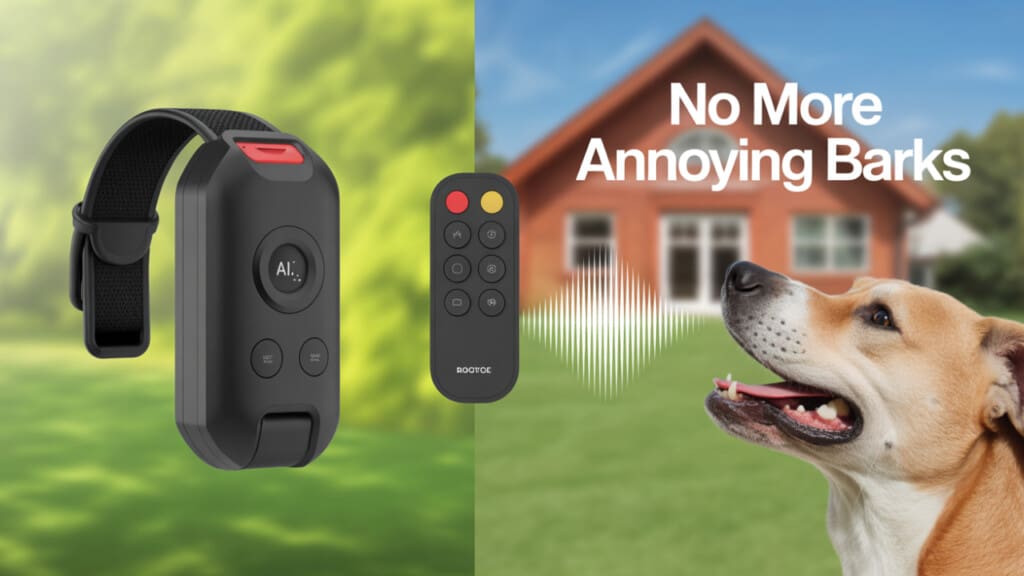
AI-Powered Collars:
New smart collars like the Halo Collar 3 use advanced GPS and AI (artificial intelligence) to more accurately track your dog’s location and when they bark. The HushPuppy collar uses AI to tell the difference between your dog’s bark and other sounds with 99.4% accuracy.
Biometric Features:
Some collars, like the Dogtra Smart NoBark, connect to smartphone apps and show you reports about your dog’s barking, whining, or howling in real-time. Other devices, like FitBark, track your dog’s activity and stress levels—though they don’t yet fully connect with bark collars, this technology is still improving.
Choose the Right Bark Collar Based on Your Dog’s Size and Breed
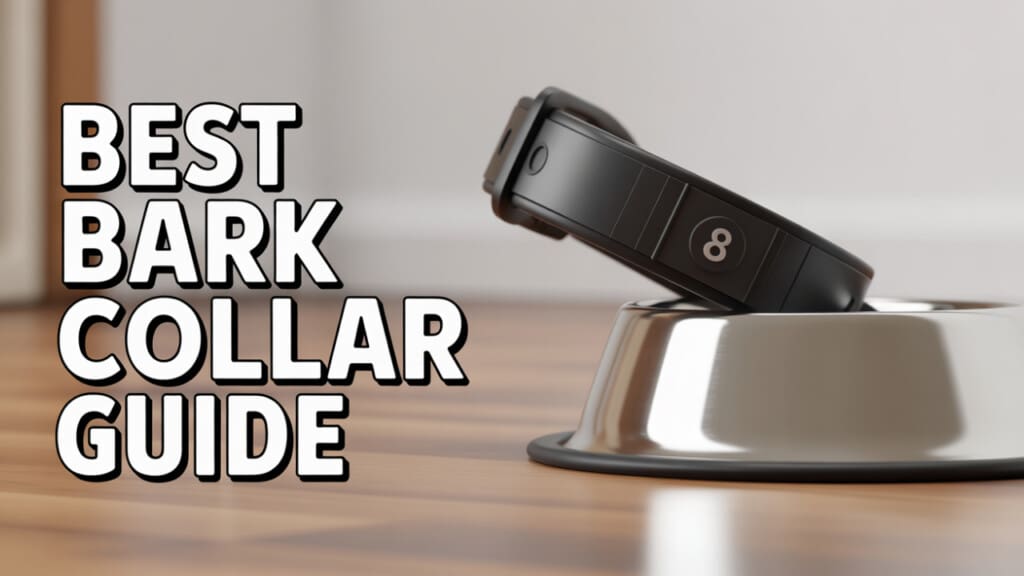
Well, not all dogs bark the same. So naturally, not all bark collars work the same for every dog.
Choosing the right bark collar based on your dog’s size and breed is one of the most critical decisions you’ll need to make when trying to curb nuisance barking.
Here’s the deal. A collar that works wonders on a 90-pound German Shepherd might overwhelm a 10-pound Chihuahua.
That’s why top-rated options like the best bark collars for small dogs focus on lightweight design, gentle vibration settings, and snug adjustability. For small breeds, anything too bulky or forceful can be distressing, or worse, unsafe.
On the other end of the spectrum, the best bark collars for big dogs are built for durability and strength. Larger dogs may require more stimulation to get their attention, which is why bark collars for large breeds often feature adjustable static or spray correction levels.
Vets commonly recommend collars with smart sensors that distinguish barking from other noises, especially for active or vocal working breeds like Huskies or Malinois.
What about medium-sized dogs? The best bark collars for medium dogs would strike a balance. Not too heavy, not too soft.
Versatile collars with multiple modes (vibration, ultrasonic, beep) are ideal here, allowing you to test what gets results without risking overstimulation.
One common mistake buyers make? Choosing based on price alone. Low-cost collars often lack the fine-tuned sensitivity needed to match different breed behaviors, leading to overcorrection or complete ineffectiveness.
And here’s another tip. Always check the manufacturer’s sizing guide. Neck circumference matters more than weight alone. Keep that in mind.
Breed-Specific Guide for Bark Collars
| Breed | Best Collar Type | Settings | Why It Works |
| Rottweiler | Static Shock Collar | Start at level 2–4 (gradual increase) | They tend to ignore soft corrections, so they need a firmer signal to respond. |
| Great Dane | Ultrasonic + Vibration | Use both sound and vibration together | Their barks are loud and deep, so dual signals help get their attention. |
| Siberian Husky | Remote-Controlled Collar | Long range (up to 1,600m) + vibration | Helps stop their howling and talkative behavior, especially when they want attention. |
Wondering what features matter most in your dog’s size category? Let’s keep going. We’ll explore the safety features that make a bark collar truly humane and effective.
Prioritize Safety and Humane Features in Bark Control Devices
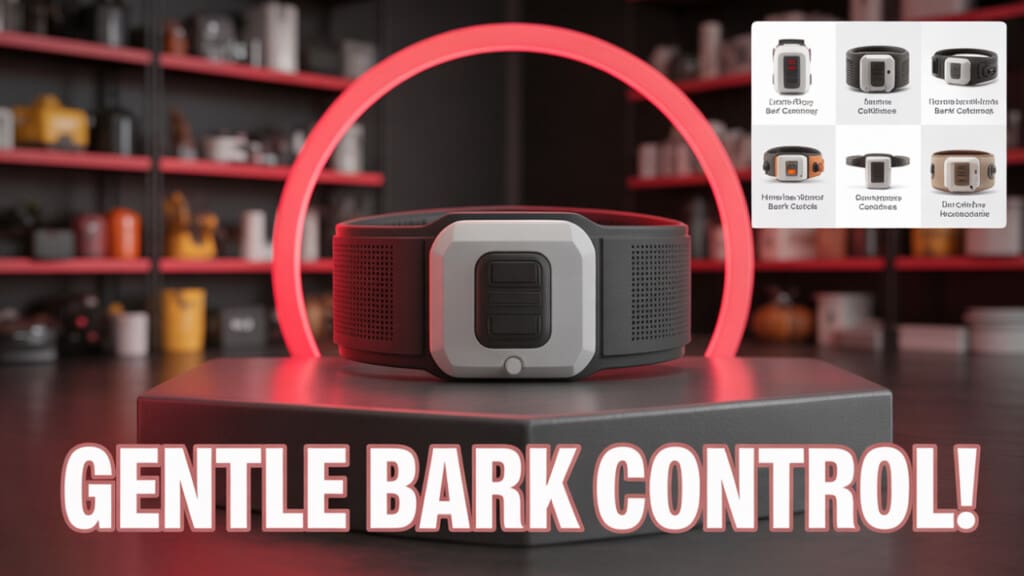
If you’re worried about whether bark collars are safe for your dog, know that you’re not alone. One of the biggest concerns among dog owners is ensuring that any bark control device used is both humane and effective.
And the truth is, not all collars meet those standards. Let’s break it down.
The most humane bark collars for dogs use non-painful methods like vibration, sound, or gentle sprays. These collars aim to distract, not punish, and they’re highly recommended for sensitive dogs or first-time users.
You should look for features like progressive correction, where the collar starts with a beep and gradually escalates only if barking continues. This ensures your dog isn’t overwhelmed or unnecessarily corrected for a single bark.
Another crucial safety feature? Automatic shut-off timers. Vets generally stress that continuous correction beyond a few seconds can lead to stress, confusion, or even trauma.
High-quality bark collars could automatically stop correcting after a short window. And this gives your dog time to reset and learn.
Watch out, though. Cheap collars often skip these safety details. Many low-cost models lack smart bark detection or adjustability.
This can lead to false triggers from other dogs, ambient noise, or even coughing. That’s why pet-safe bark collars from reputable brands are worth the extra investment. You’re paying for your dog’s well-being, not just tech.
Most experts say that a safe bark collar should also be adjustable to fit properly and include soft, rounded contact points to prevent skin irritation.
And if you’re using a spray collar, always check the ingredients. Citronella is generally safe in small doses. But it should never come into contact with your dog’s eyes or face.
Ready to compare collar modes and control settings? The next section will help you decide whether an automatic or remote-controlled collar makes more sense for your lifestyle and training goals.
Legal Warning: 2025 Rules on Shock Collars
Shock collars are banned in several countries like Germany, Denmark, Norway, Sweden, Austria, Switzerland, and Wales. In Australia, the rules depend on the state—fully banned in New South Wales (NSW) and South Australia (SA), but allowed with restrictions in Queensland and Victoria.
Always check your local laws before buying a shock collar.
Decide Between Automatic Bark Collars and Remote-Control Options
Wondering whether an automatic bark collar or a remote-control option is the better choice for your dog? This is one of the most important decisions you’ll make.
The right answer will depend entirely on your lifestyle, training style, and your dog’s behavior patterns.
Here’s the thing. Automatic bark collars are designed for set-it-and-forget-it use. These smart collars detect barking through vibration or sound sensors and deliver a preset correction, usually a beep, vibration, or spray, without requiring manual input.
They’re perfect for owners who aren’t always home or who want consistent correction when they’re not present. The best automatic bark collars for dogs often include multi-mode functionality, progressive correction levels, and intelligent sensors to avoid false triggers.
On the flip side, remote-control bark collars give you complete control over when and how your dog is corrected. You press the button in real time, typically using a handheld transmitter.
This makes remote collars ideal for active training sessions, dogs with specific triggers (like barking at the doorbell), or households with multiple pets.
Pet trainers say that remote collars allow for more personalized correction and help avoid confusing your dog. But they do require your active participation.
So, what’s the common mistake? Choosing a remote model expecting it to work passively. Some buyers assume the best bark collars for dogs will “just work” out of the box, only to find their dog barking when they’re away because the device doesn’t operate independently.
From a cost standpoint, remote-controlled options tend to be more expensive because of the extra hardware. However, both types offer budget and premium models, with smart bark collars blurring the line by offering app-controlled hybrid features.
Still unsure which system fits your routine? Keep reading. Next, we’ll break down how long it typically takes to see results with these devices and what you should expect during the training process.
Know What Results to Expect and How Long It Takes to Work
If you’re investing in a bark collar, one of your biggest questions is probably this. How soon will I see results?
The answer depends on your dog’s personality, the type of collar you choose, and how consistently it’s used. But most owners report noticeable improvements within a few days to a week.
Here’s why it matters. Even the best bark collars for dogs aren’t magic buttons. They’re tools designed to interrupt a habit, not erase it instantly.
For example, some of the best bark control collars for dogs typically include progressive correction levels that gently escalate if barking continues.
This helps teach your dog over time that barking triggers an unwanted response. But timing, consistency, and correct fit all play major roles in how fast your dog responds.
What does this mean for you? If your dog is particularly vocal, anxious, or stubborn, it may take longer to adjust.
We recommend pairing the collar with positive reinforcement, such as treats or praise, when your dog remains quiet, to speed up training and create a positive learning loop.
One of the most common mistakes buyers make is assuming the collar will solve everything overnight.
Without setting realistic expectations (or worse, using the collar inconsistently), you’ll often feel the product “doesn’t work.” But in reality, the dog hasn’t even had time to adapt.
From a cost-efficiency standpoint, automatic bark collars offer steady, hands-off correction that helps maintain consistent feedback, even when you’re not home. That alone can shorten the learning curve.
Keep this in mind. Progress with bark collars is often incremental but lasting. If you’re patient and consistent, you’ll likely see clear improvement within the first 5 to 10 days.
Are you curious about what advice vets offer when it comes to controlling barking safely? The next section covers exactly that.
What do vets recommend to stop dogs from barking?
If your dog’s barking has become a daily disruption, you might be wondering. What do the professionals suggest?
The truth is, vets don’t jump straight to bark collars. They look at the whole picture. Their recommendations often combine behavioral strategies with safe, humane tools to get long-term results without harming your pet’s well-being.
Let’s break it down. Veterinarians typically start by identifying the why behind the barking. Is it boredom? Separation anxiety? Territorial behavior?
Experts say that barking is rarely just “bad behavior.” It’s usually communication that’s gone unmanaged.
For this reason, positive reinforcement training, environmental enrichment, and routine adjustments are top-tier recommendations. That might mean puzzle toys, extra walks, or teaching a “quiet” command reinforced with treats.
But when the barking is persistent and disruptive, vets may suggest bark control devices, naturally with a strong preference for humane models.
The best humane bark collars for dogs, for example, use vibration, sound, or spray rather than shock. These options are more in line with veterinary ethics and are considered safer, especially for small or sensitive breeds.
But here’s the catch. Many pet owners go straight to high-intensity correction tools without addressing the underlying cause.
This can backfire, causing anxiety or even increasing barking due to confusion or stress. That’s why a vet-approved plan usually combines a mild bark collar with targeted training and patience.
In terms of cost, humane collars may be slightly more expensive up front but are well worth it when you factor in safety and results. And if you’re dealing with anxiety-based barking, some vets may even recommend temporary use of calming aids alongside training.
Looking to avoid common buying mistakes? In the next section, we’ll cover the most frequent pitfalls people face when shopping for the best bark collars for dogs and how to steer clear of them.
Common Mistakes to Avoid When Buying a Bark Collar
Bark collars can be incredibly effective tools, but only when chosen and used correctly.
Unfortunately, many dog owners unknowingly make purchasing mistakes that lead to poor results, wasted money, or even harm to their pets. Let’s uncover the biggest traps to avoid.
Mistake 1: Buying based on price alone.
It’s tempting to grab the cheapest option on Amazon, but low-cost collars often lack basic safety features like automatic shut-off or adjustable sensitivity.
These models may misfire, triggering corrections at the wrong time, or may not be strong enough to make an impact at all.
The cost of replacing an ineffective collar (or worse, treating stress-related side effects) quickly outweighs the original savings.
Mistake 2: Choosing the wrong collar for your dog’s size or temperament.
A collar that’s too intense can frighten small or timid dogs, while one that’s too gentle won’t phase a large or determined barker.
The best bark collars for big dogs are not the same as those designed for smaller breeds. Always match the correction strength, fit, and technology to your specific dog.
Mistake 3: Ignoring fit and comfort.
A collar that’s too tight can cause chafing or breathing issues. Too loose? It won’t activate consistently.
Adjustable bark collars with padded contacts are ideal. And they’re worth the minor price increase for your dog’s comfort and safety.
Mistake 4: Expecting instant results.
Bark collars are most effective when paired with positive reinforcement and used consistently over time. Many returns and complaints happen simply because buyers don’t give the collar enough time to work.
Here’s a pro tip. Always read user reviews from owners of similar-sized or same-breed dogs. That real-world insight is often more valuable than specs on the box.
Are you ready to finalize your buying decision? Stick around then. The upcoming FAQ section covers the last-minute questions most buyers ask before clicking “Add to Cart.”
FAQs About Buying the Best Bark Collars for Dogs
Choosing the best bark collar can feel overwhelming, especially with so many options and opinions floating around. To make your decision easier, here are answers to the top 10 real-world questions buyers like you ask before making a purchase.
Each one cuts through the noise and helps you move forward with clarity and confidence.
1. Do vets recommend anti-bark collars?
Yes, many vets recommend anti-bark collars as part of a broader behavior modification plan, especially when barking is excessive and other methods haven’t worked. They tend to prefer humane options like vibration or spray collars over static shock models.
2. What really works to stop a dog from barking?
The most effective approach combines positive reinforcement with a well-fitted bark collar that matches your dog’s size and temperament. Training consistency matters just as much as the tool itself.
3. What’s the best thing to stop dogs from barking?
A customized bark collar (vibration, ultrasonic, or spray) paired with training is often the most reliable solution. For some dogs, increased physical activity and mental enrichment may significantly reduce barking as well.
4. Are no-shock bark collars effective?
Absolutely! For many dogs, no-shock collars using vibration or sound cues work well, especially if the barking isn’t aggressive or obsessive. These collars are safer for smaller or more sensitive breeds.
5. What is the safest bark collar for small dogs?
The safest option is a lightweight, vibration-based collar with automatic shut-off features. Look for adjustable sensitivity and a snug fit to avoid accidental overcorrection.
6. Should I get a bark collar with a remote or automatic mode?
It depends on your training style. Remote collars are great for active training, while automatic bark collars are better for passive correction when you’re not home.
7. Can bark collars be used on puppies?
Bark collars are generally not recommended for puppies under 6 months, as their vocal behavior is still developing. Focus on basic training and socialization first.
8. How long does it take for a bark collar to show results?
Most dogs show noticeable improvement within 3 to 10 days. The key is consistency and proper collar placement.
9. Do bark collars work for large, stubborn dogs?
Yes, but you’ll want a collar specifically designed for bigger breeds. The best bark collars for big dogs include stronger vibration or adjustable correction levels to cut through distractions.
10. Is it better to buy bark collars online or in-store?
Online shopping offers more variety, detailed reviews, and better pricing. But be sure to buy from reputable retailers that offer return policies in case the collar isn’t a good fit.
If you’re still weighing your options, use these FAQs as a quick-reference guide during your shopping process. The more informed your purchase, the better the results for both you and your dog.
What’s the Smartest Way to Choose the Right Bark Collar Today?
Here’s what that means for you. Buying the right bark collar doesn’t have to be a gamble.
With the insights you’ve just gained – from vet-recommended safety features and device types tailored by breed, to common buyer mistakes like ignoring fit or underestimating sensitivity settings – you’re now equipped to make a smarter, safer, and more effective choice for your dog.
Whether you go for a gentle vibration collar for your small pup or a remote-controlled option for a more stubborn breed, you now know what actually works and what to avoid.
Feeling ready to find the perfect fit? Start by comparing well-reviewed options with automatic shut-offs, adjustable modes, and sizing that matches your dog’s needs. A quieter, calmer home is just a few thoughtful decisions away.
What’s worked for your dog? A bark collar? A training method? Share your experience and tips in the comments below!

